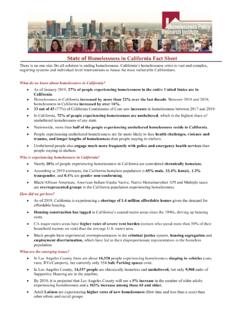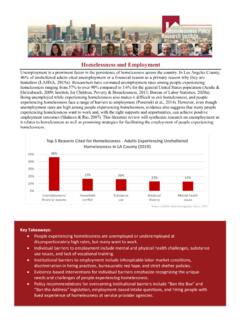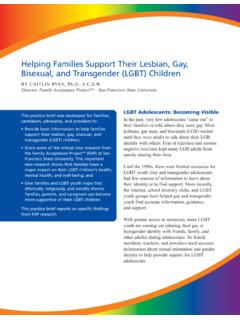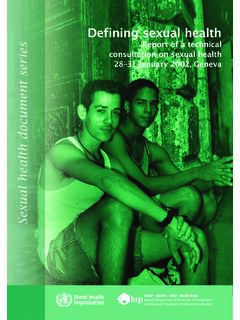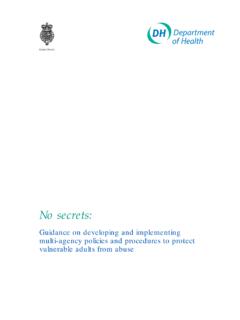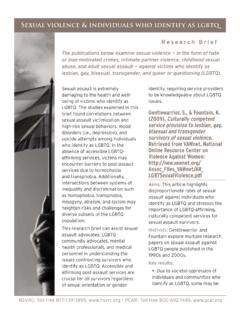Transcription of LGBTQ Youth Experiencing Homelessness
1 Key Takeaways: LGBTQ Youth are more likely to experience Homelessness than their heterosexual and cisgender peers A higher percentage of LGBTQ Youth Experiencing Homelessness in Los Angeles are unsheltered in comparison to heterosexualand cisgender Youth Experiencing Homelessness , illustrating a reluctance by LGBTQ Youth to seek shelter, and/or a failure byshelters in providing LGBTQ Youth with accessible, safe spaces If unsheltered, LGBTQ Youth suffer from greater levels of physical and sexual assault, mistreatment by police, and sexualpropositioning in comparison to other homeless Youth Transgender homeless Youth specifically exhibit an even greater risk of bullying.
2 Family rejection, and sexual abuse In attempts to find shelter and support, LGBTQ Youth are at greater risk of both discrimination that denies access and exploitationthat deters them from otherwise beneficial programs and servicesLGBTQ Youth Experiencing Homelessness Background Lesbian, gay, bisexual, transgender, and questioning/queer ( LGBTQ ) Youth are overrepresented in the population Experiencing Homelessness in the United States. Although exact numbers are hard to find due to uneven disclosure of sexual orientation and gender identity from Youth , somewhere between 20 to 40% (300,000 to 600,000) of Youth Experiencing Homelessness identify as LGBTQ compared to 4 to 10% of the total Youth population (Cunningham, 2014; Maccio & Ferguson, 2012).
3 Estimates suggest that LGBTQ Youth are anywhere from 2 to 13 times more likely to experience Homelessness compared to heterosexual and cisgender Youth (Coolhart & Brown, 2017). Studies also find that leaving home due to conflict with guardians over sexual orientation or gender expression is the primary reason for housing instability among LGBTQ Youth (Choi et al., 2015). Once they leave home, LGBTQ Youth experience higher rates of violence, physical and mental health degradation, and exploitation when compared to other Youth Experiencing Homelessness . Given this disparity, housing researchers, policymakers, and service providers should pay special attention to this sub-group of the population Experiencing Homelessness in order to effectively combat their distinct outcomes.
4 This literature review documents current research about the scope, underlying causes, and unique characteristics of LGBTQ Youth Homelessness in Los Angeles. Source: LAHSA, 2018 47%51%38%78%52%55%61%62%0%10%20%30%40%50 %60%70%80%90%All HomelessYouthMaleFemaleTransgenderStraig htGay orLesbianBisexualQuestioningPercent of Youth Experiencing Homelessness that are Unsheltered by gender Identity & sexual OrientationLiterature Review Background and Research Motivation LGBTQ Youth are overrepresented in the total Youth population Experiencing Homelessness . According to the LGBTQ Homeless Youth Provider Survey, 20% of Youth seeking homeless services identify as gay or lesbian, 7% identify as bisexual, and 2% identify as questioning (Choi et al.)
5 , 2015). Comparatively, 4% of the total US population identifies as LGBTQ (The Williams Institute, 2019). Five percent of Youth Experiencing Homelessness identified as transgender (Choi et al., 2015) compared to less than 1 percent of the total US population (Flores et al., 2016). LGBTQ Youth Experiencing Homelessness are also disproportionately Black. In 2015, 31% of LGBTQ clients identified as Black, compared to only 14% of the total Youth population (Choi et al., 2015; The Annie E. Casey Foundation, 2017). The share of Youth accessing homeless services have increasingly identified as LGBTQ over the past 10 years, with the share of transgender Youth accessing services growing the fastest from to 5%.
6 Due to their growing overrepresentation in the population of Youth Experiencing Homelessness , this literature review provides an overview of what we know about the unique causes, challenges, and policy approaches to LGBTQ Youth Experiencing Homelessness . Unique Causes & Challenges Service providers report that the most common reason cited for Experiencing Homelessness by LGBTQ Youth is either being kicked out by their parents or running away from home due to family conflict over their sexual orientation or gender identity. 55% of LGBTQ Youth cited this cause, while only 17% reported the second highest reason of general family issues. For transgender Youth , 67% conveyed that being forced out or running away caused their Homelessness , with only 7% reporting general family issues (Choi et al.)
7 , 2015). This highlights the need for service providers to focus on family counseling and interventions for this group of Youth Experiencing Homelessness . Furthermore, the additional trauma of family conflict and the potential for domestic violence illustrates the distinct vulnerability of this segment of the Youth population Experiencing Homelessness . After being forced from their homes, LGBTQ Youth suffer higher rates of depression and mental health problems than their heterosexual and cisgender peers Experiencing Homelessness who already exhibit higher rates of these conditions when compared to housed Youth (Cunningham et al., 2014). Unsheltered Once living on the street, LGBTQ Youth are at greater risk of physical and sexual abuse from adults and other Youth .
8 On average, LGBTQ Youth experience seven more acts of sexual violence while Experiencing Homelessness compared to heterosexual or cisgender Youth (Lambda Legal, 2019). Moreover, research shows that one in three LGBTQ Youth Experiencing Homelessness have been a victim of a hate crime based on their sexual orientation or gender identity (Cray, Miller, & Durso, 2013). Unsheltered LGBTQ Youth also face disproportionate targeting and violence from police based on their gender expression, contributing to notably low levels of self-reported trust for authority figures (Cray, Miller, & Durso, 2013). This mistrust undermines the likelihood that they actively seek help from shelters and service providers.
9 LGBTQ Youth Experiencing Homelessness are also found to be more likely to take part in risky sexual behavior, use drugs, and be HIV positive in comparison to the overall Youth population August 19, 20192experiencing Homelessness (Cunningham et al., 2014). Related to this increased risk, they are also statistically more likely to be propositioned in exchange for money, food, shelter, or clothing compared to heterosexual or cisgender Youth Experiencing Homelessness (Lambda Legal, 2019). These factors help to explain the higher rates of sexual abuse, exploitation, and sex trafficking reported by LGBTQ Youth Experiencing Homelessness (Cray, Miller, & Durso, 2013). The challenges that arise without shelter are particularly alarming considering that a higher percentage of Youth Experiencing Homelessness in Los Angeles that identify as lesbian or gay (55%), bisexual (61%), transgender (78%), or questioning (62%) are unsheltered in comparison to those that identify as heterosexual (52%), cisgender male (51%), or cisgender female (38%) (LAHSA, 2018).
10 Seeking Help Given that LGBTQ Youth are more likely to be unsheltered than other Youth Experiencing Homelessness , housing providers should consider ways to make housing services accessible, respectful, and safe for LGBTQ Youth . When attempting to access housing and other support services, LGBTQ Youth often experience discrimination and exploitation by service providers or other Youth . Discriminatory practices and policies place barriers between LGBTQ Youth and the services they need to establish housing stability (Lambda Legal, 2019). Qualitative interviews inside shelters from providers and LGBTQ Youth convey that shelter gender segregation and being assigned the wrong gender category creates significant emotional distress for LGBTQ Youth (Coolhart & Brown, 2017).


